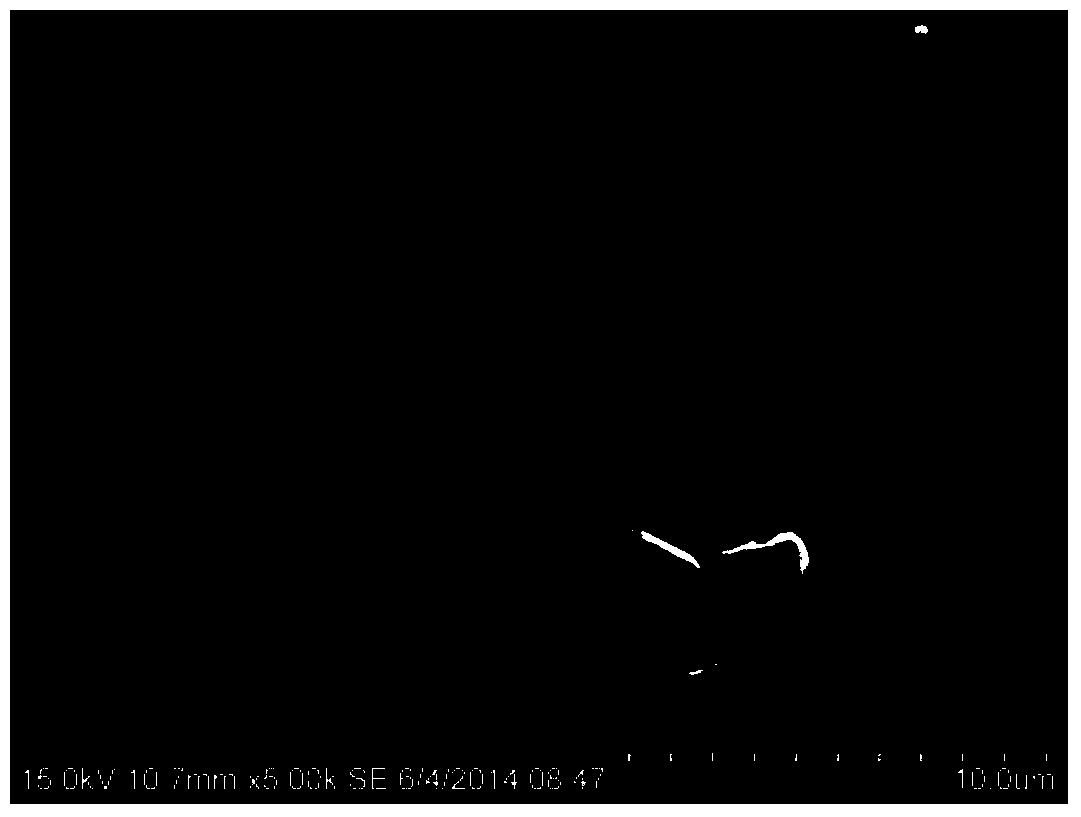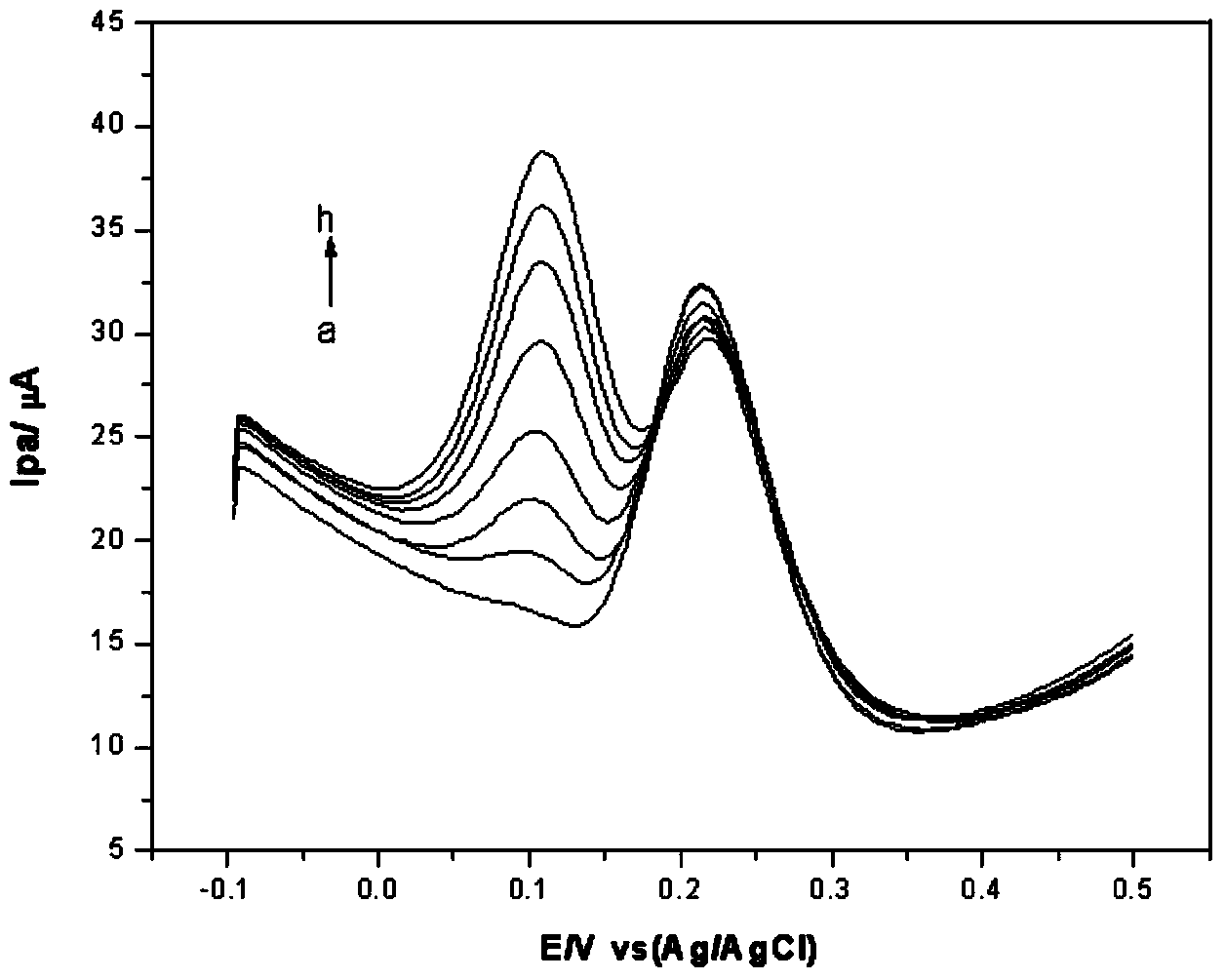Preparation method of glassy carbon electrode for detecting pyrocatechol and/or paradioxybenzene in water
A glassy carbon electrode and catechol technology, applied in the field of electrodes, can solve the problems of no improvement in sensitivity, stability and repeatability technical effects, rising and lowering of glassy carbon electrode costs, and achieve high sensitivity, low equipment requirements, good repeatability
- Summary
- Abstract
- Description
- Claims
- Application Information
AI Technical Summary
Problems solved by technology
Method used
Image
Examples
example 1
[0024] Example 1 (preparation of glassy carbon electrode)
[0025] 1. Preparation of nitrogen-doped graphene oxide
[0026] (1) The graphite raw material is oxidized to graphite oxide by the improved Hummers method
[0027] 10g of potassium persulfate (K 2 S 2 o 8 ), 10g phosphorus pentoxide (P 2 o 5 ) and 12g of graphite powder were added to 50mL of 80°C concentrated sulfuric acid (H 2 SO 4 )middle. The above solution was kept at 80° C. and stirred for 4.5 h. After cooling to room temperature, it was diluted with 2 L of deionized water and allowed to stand overnight. The supernatant was decanted, and the pellet was washed several times with deionized water and centrifuged.
[0028] Add concentrated sulfuric acid to the precipitate to the concentration of the precipitate in the concentrated sulfuric acid is 40mg / mL, place in an ice-water bath, slowly add 7g of potassium permanganate (KMnO 4 ), and keep the solution temperature below 10°C. After the mixture was stirr...
example 2
[0046] Example 2 (inspection of main technical indicators of glassy carbon electrode)
[0047] (1) The nitrogen-doped graphene oxide-modified glassy carbon electrode prepared in Example 1 was used as the working electrode, the Ag / AgCl electrode was used as the reference electrode, and the platinum electrode was used as the counter electrode to establish a three-electrode system with an electrolytic cell.
[0048] (2) adding hydroquinone (abbreviated as HQ) and catechol (abbreviated as CC) standard substance respectively to pH 6.5, concentration is 0.1mol L -1 In the phosphate buffer solution, the concentrations were prepared to be 1×10 -6 mol / L, 10×10 -6 mol / L, 20×10 -6 mol / L, 40×10 -6 mol / L, 80×10 -6 mol / L, 120×10 -6 mol / L, 160×10 -6 mol / L and 200×10 -6 8 concentrations of hydroquinone standard solution and 8 concentrations of catechol standard solution of mol / L; because hydroquinone and catechol often exist in waste water at the same time, therefore, in 8 Concentrati...
example 3
[0052] Example 3 (the effect of the ratio of different graphene oxide and ammonium carbonate on the amount of nitrogen doping)
[0053] 1. Get 20 mg of single-layer graphene oxide obtained in the step (2) of the method for preparing nitrogen-doped graphene oxide in example 1, dissolve it in 10 ml distilled water, and ultrasonically disperse to obtain a graphene oxide solution of 2 mg / mL. Add 3.6g of ammonium carbonate to the liner of the tetrafluoroethylene hydrothermal reaction kettle and stir until dissolved. The hydrothermal reaction kettle was placed at 130° C. for 10 h to obtain a black solid precipitate. The precipitated product was continuously washed with deionized water to remove impurities, and the precipitate was dried in an oven at 35° C. for 10 h to obtain sample A of nitrogen-doped graphene oxide.
[0054] 2. Get 20 mg of single-layer graphene oxide obtained in step (2) of the method for preparing nitrogen-doped graphene oxide in example 1, dissolve it in 10 ml ...
PUM
 Login to View More
Login to View More Abstract
Description
Claims
Application Information
 Login to View More
Login to View More - R&D
- Intellectual Property
- Life Sciences
- Materials
- Tech Scout
- Unparalleled Data Quality
- Higher Quality Content
- 60% Fewer Hallucinations
Browse by: Latest US Patents, China's latest patents, Technical Efficacy Thesaurus, Application Domain, Technology Topic, Popular Technical Reports.
© 2025 PatSnap. All rights reserved.Legal|Privacy policy|Modern Slavery Act Transparency Statement|Sitemap|About US| Contact US: help@patsnap.com



